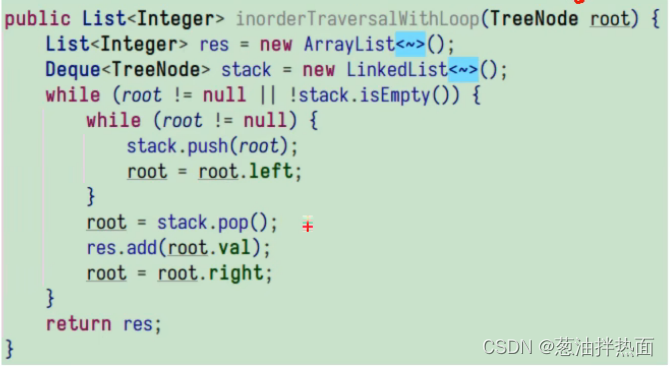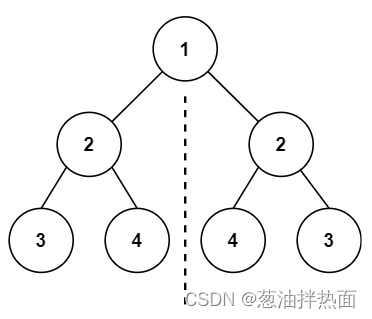二叉树的遍历题目
二叉树遍历一般包含三种分别为:根左右、左根右、左右根(又称为前序遍历、中序遍历、后序遍历)
方法一:使用递归遍历 方法二:使用迭代使用栈
我们以左根右(中序遍历)为例:下列代码中,我们在遍历题目中我们展示方法二,用来存储我们的运行过程中访问到的结点。
- 第一个while如果根结点不是空或者栈不是空的,我们就循环执行
- 第二while,当根结点不为空时,把结点放到我们的栈中,并访问根的左子树
- 当没有左子树可访问后,提取出栈的最后一个进入的子树
- 把该子树放到列表中
- 然后再访问该结点的右子树,(但是由于该结点没有右子树时,这重新进入循环,重复1-5这些步骤)

上述步骤如有不清楚,可以参考下图卡片链接视频,视频第9分钟的时候
1-024-_(LeetCode-94) 二叉树的中序遍历_哔哩哔哩_bilibili![]() https://www.bilibili.com/video/BV1eg411w7gn?p=25&vd_source=6d86118bce41ec0856a5d50f6c17a7e7上述代码,无论是前中后序遍历,只要将res.add(root.val)移动一下位置即可,在前序中,把该代码反到循环内,在每次访问根节点的时候,直接将根节点的值放到res中;
https://www.bilibili.com/video/BV1eg411w7gn?p=25&vd_source=6d86118bce41ec0856a5d50f6c17a7e7上述代码,无论是前中后序遍历,只要将res.add(root.val)移动一下位置即可,在前序中,把该代码反到循环内,在每次访问根节点的时候,直接将根节点的值放到res中;
而后序则是完全不一样,由于在访问结点过程中先访问左结点后,必须访问右结点(除没有右节点外),所以在出栈后的结点,需查找它的右节点,找到好先对右节点进行排序,最后再排出栈的结点。所以其算法编写为:
java
class Solution {
public List<Integer> preorderTraversal(TreeNode root) {
List<Integer> res = new ArrayList<>();
Deque<TreeNode> stack = new LinkedList<>();
TreeNode prevAccess = null;
while(root!=null || !stack.isEmpty()){
while(root!=null){
stack.push(root);
root = root.left;
}
root = stack.pop();
if(root.right == null || root.right == prevAccess){
res.add(root.val);
prevAccess = root;
root =null;
}else{
stack.push(root);
root = root.right;
}
}
return res;
}
}若有不懂得题目,可以点击下面卡片链接1-026-(LeetCode-145) 二叉树的后序遍历_哔哩哔哩_bilibili![]() https://www.bilibili.com/video/BV1eg411w7gn?p=27&vd_source=6d86118bce41ec0856a5d50f6c17a7e7
https://www.bilibili.com/video/BV1eg411w7gn?p=27&vd_source=6d86118bce41ec0856a5d50f6c17a7e7
二叉树镜像对称题目

解决方法一:定义一个递归方法,循环遍历左子树的左孩子和右子树的右孩子进行比较,在比较左右孩子和右左孩子
java
/**
* Definition for a binary tree node.
* public class TreeNode {
* int val;
* TreeNode left;
* TreeNode right;
* TreeNode() {}
* TreeNode(int val) { this.val = val; }
* TreeNode(int val, TreeNode left, TreeNode right) {
* this.val = val;
* this.left = left;
* this.right = right;
* }
* }
*/
class Solution {
public boolean isSymmetric(TreeNode root) {
if(root == null){
return true;
}
return deepCheck(root.left,root.right);
}
boolean deepCheck(TreeNode left, TreeNode right){
if(left==null && right==null){
return true;
}
if(left==null || right==null){
return false;
}
if(left.val != right.val){
return false;
}
return deepCheck(left.left,right.right)&& deepCheck(left.right,right.left);
}
}方法二:循环迭代的方法,这里用到了队列
这里可以看下面卡片第三分钟 有所介绍:1-027-(LeetCode-101) 对称二叉树_哔哩哔哩_bilibili![]() https://www.bilibili.com/video/BV1eg411w7gn?p=28&vd_source=6d86118bce41ec0856a5d50f6c17a7e7
https://www.bilibili.com/video/BV1eg411w7gn?p=28&vd_source=6d86118bce41ec0856a5d50f6c17a7e7
java
public class Soultion {
pubilic boolean isSymmetric(TreeNode root) {
Queue<TreeNode> q = new LinkedList<TreeNode>();
TreeNode u = root.left;
TreeNode v = root.right;
if(root == null|| (u == null && v == null)){
return true;
}
//入队
q.offer(u);
q.offer(v);
while(!q.isEmpty()){
//队列取出操作
u = q.poll();
v = q.poll();
while (!q.isEmpty()){
u = q.poll();
v = q.poll();
if(u == null && v == null){
continue;
}
if((u==null|| v==null) ||(u.val! = v.val)){
return false;
}
q.offer(u.left);
q.offer(v.right);
q.offer(u.right);
q.offer(v.left);
}
return true;
}
}
}二叉树最大深度算法问题
方法一:递归解决方法
java
/**
* Definition for a binary tree node.
* public class TreeNode {
* int val;
* TreeNode left;
* TreeNode right;
* TreeNode() {}
* TreeNode(int val) { this.val = val; }
* TreeNode(int val, TreeNode left, TreeNode right) {
* this.val = val;
* this.left = left;
* this.right = right;
* }
* }
*/
class Solution {
public int maxDepth(TreeNode root) {
if(root == null){
return 0;
}
else{
return Math.max(maxDepth(root.left),maxDepth(root.right))+1;
}
}
}方法二:迭代循环方法,这里仍然用到队列
java
public class Soultion {
public int maxDepthWithQueue(TreeNode root) {
if(root == null){
return 0;
}
Queue<TreeNode> queue = new LinkedList<>();
queue.offer(root);
int depth = 0;
while (!queue.isEmpty()) {
//size记录本层的结点是否全部解决完
int size = queue.size();
while(size>0){
TreeNode node = queue.poll();
if (node.left!= null) {
queue.offer(node.left);
}
if (node.right!= null) {
queue.offer(node.right);
}
size--;
}
depth++;
}
return depth;
}
}一分43秒
平衡二叉树题目
什么是平衡二叉树: 一个二叉树每个结点的左右两个子树的高度差的绝对值不超过1。

用递归方式实现:
java
/**
* Definition for a binary tree node.
* public class TreeNode {
* int val;
* TreeNode left;
* TreeNode right;
* TreeNode() {}
* TreeNode(int val) { this.val = val; }
* TreeNode(int val, TreeNode left, TreeNode right) {
* this.val = val;
* this.left = left;
* this.right = right;
* }
* }
*/
class Solution {
public boolean isBalanced(TreeNode root) {
if(root == null){
return true;
}
//调用递归方法
return helper(root)!=-1;
}
public int helper(TreeNode root){
if(root==null){
return 0 ;
}
//统计左右子树的高度
int left = helper(root.left);
int right = helper(root.right);
//比较
if(left == -1 || right == -1 || Math.abs(left - right)>1){
return -1;
}
return Math.max(left,right)+1;
}
}翻转二叉树题目

用递归的形式解题
java
/**
* Definition for a binary tree node.
* public class TreeNode {
* int val;
* TreeNode left;
* TreeNode right;
* TreeNode() {}
* TreeNode(int val) { this.val = val; }
* TreeNode(int val, TreeNode left, TreeNode right) {
* this.val = val;
* this.left = left;
* this.right = right;
* }
* }
*/
class Solution {
public TreeNode invertTree(TreeNode root) {
if(root == null){
return null;
}
//翻转根结点的左孩子
invertTree(root.left);
//翻转根结点的右孩子
invertTree(root.right);
TreeNode temp = root.left;
//然后左右孩子交换
root.left= root.right;
root.right =temp;
return root;
}
}